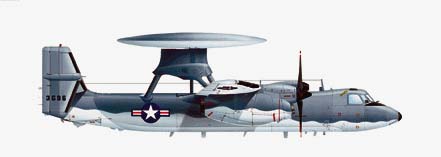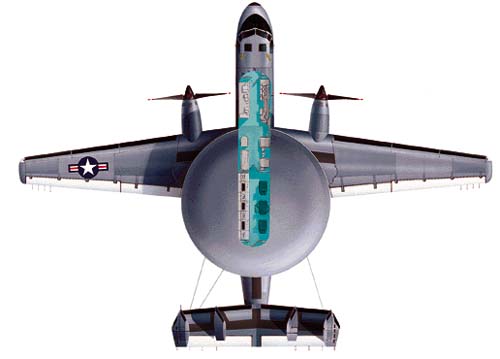





The E-2C Hawkeye is the U.S. Navy's all-weather, carrier-based tactical airborne warning and control system platform. It provides all-weather airborne early warning and command and control functions for the carrier battle group. Additional missions include surface surveillance coordination, strike and interceptor control, search and rescue guidance and communications relay.
An integral component of the carrier air wing, the E-2C carries three primary sensors: radar, IFF, and a passive detection system. These sensors are integrated through a general purpose computer that enables the E-2C to provide early warning, threat analyses, and control of counter action against air and surface targets. The E-2C incorporates the latest solid state electronics.
Carrier-based E-2C Hawkeye airborne early warning aircraft directed F-14 Tomcat fighters that provided combat air patrol during the two-carrier battle group joint strike against terrorist-related Libyan targets in 1986, and during the crisis period preceeding and following the strike. E-2Cs and AEGIS cruisers, working together, provided total air mass superiority over the American fleet. During this time, American aircraft made 153 intercepts of Libyan air force attempts to overfly the U.S. fleet, intercept the U.S. fighter combat air patrol, or gather intelligence information. Not once did a Libyan aircraft get into firing position before it was locked into the sights of a U.S. aircraft or AEGIS platform missile.
There currently is one squadron of four Hawkeyes in each carrier air wing (CVW).
E-2 aircraft also have worked extremely effectively with U.S. law enforcement agencies in drug interdiction operations. The E-2C replaces the E-2B, an earlier version. E-2C aircraft entered U.S. Navy service with Airborne Early Warning Squadron 123 (VAW-123) at NAS Norfolk, Va., in November 1973. Procurement of E-2Cs by the Navy is planned at six per year for FY 1988-98.
The E-2C+ upgrade includes radar improvements, software upgrades, and more powerful engines. Further plans include upgrading the whole E-2 fleet to Block I and II status, which mean a new radar (APS-139 and APS-145, respectively) and overall improved processing capability.
On 26 April 1999 Northrop Grumman was awarded a $1,305,400,000 multiyear advanced acquisition contract for the procurement of 21 airborne early warning E-2C aircraft in the Hawkeye 2000 configuration for the US Navy, and long lead material for one aircraft for the government of France under the Foreign Military Sales Program. Work will be performed in St. Augustine, Fla. (80%), and Bethpage, N.Y. (20%), and is expected to be completed by July 2006.
Taiwan received four E-2T [for Taiwan] Hawkeyes as of September 1995 as part of a $749.5 million deal with US firm Northrop Grumman. In conjunction with F-16 and Mirage 2000 fighters, the E-2Ts will enhance Taiwan's air defence capability, increasing attack warning times from five minutes to 25 minutes.
| E-2C/E-2C+ AIRCRAFT
DESCRIPTION Contractor: Northrop Grumman (Prime), Westinghouse Type: Early warning and control aircraft Power Plant: E-2C: Two Allison T56-A-425 turboprops; each has approximately 4,600 horsepower E-2C+: Two Allison T56-A-427 engines; each has approximately 5,100 horsepower; since 1988 Accommodations: Crew of five—two pilots and three operators. Performance: E-2C: maximum speed 350 knots; range 1,300 nautical miles E-2C+: maximum speed 350 knots; range 1,500 nautical miles Countermeasures: Not applicable Armament: E-2C:
Lockheed Martin Ocean,
Radar, and Surveillance Systems [ex General Electric Corporation] AN/APS-138 radar since 1984; E-2C+: Lockheed Martin Ocean, Radar, and Surveillance Systems [ex General Electric Corporation] AN/APS-145 radar since 1991 All: AN/ALR-73 Passive Detection System, IFF Mission and Capabilities:
Program Summary:
E-2 TECHNICAL DATA: External Dimensions
Areas
Weights and Loadings
Performance (at maximum Takeoff Weight)
| |||||||||||||||||||||||||||||||||||||||||||||||||||||||||||||||||||||||


